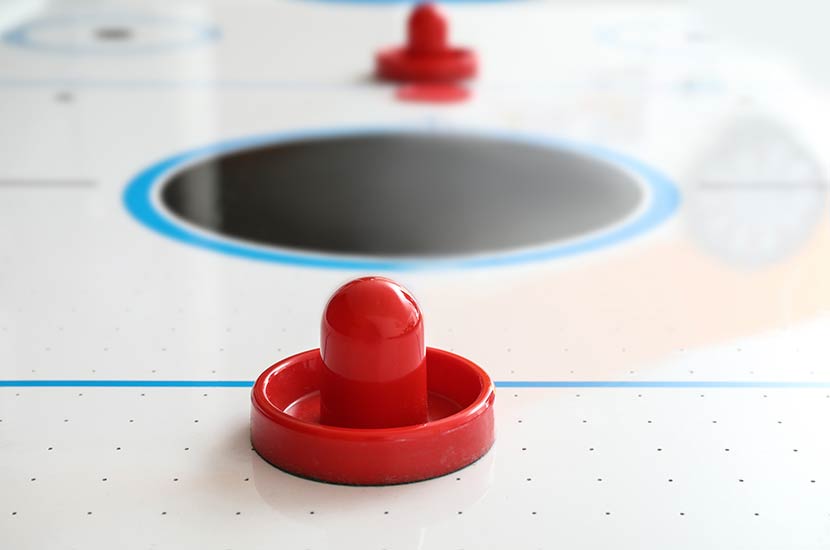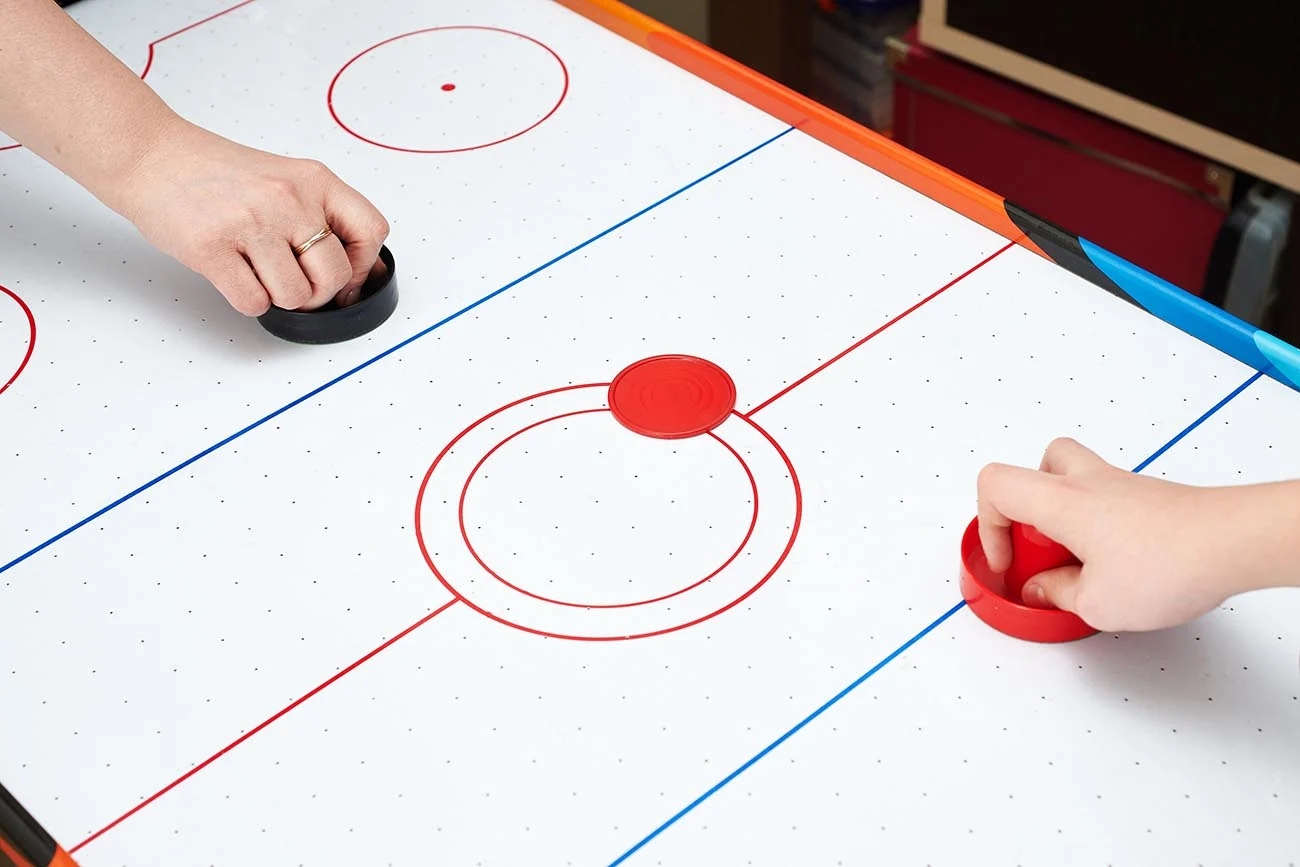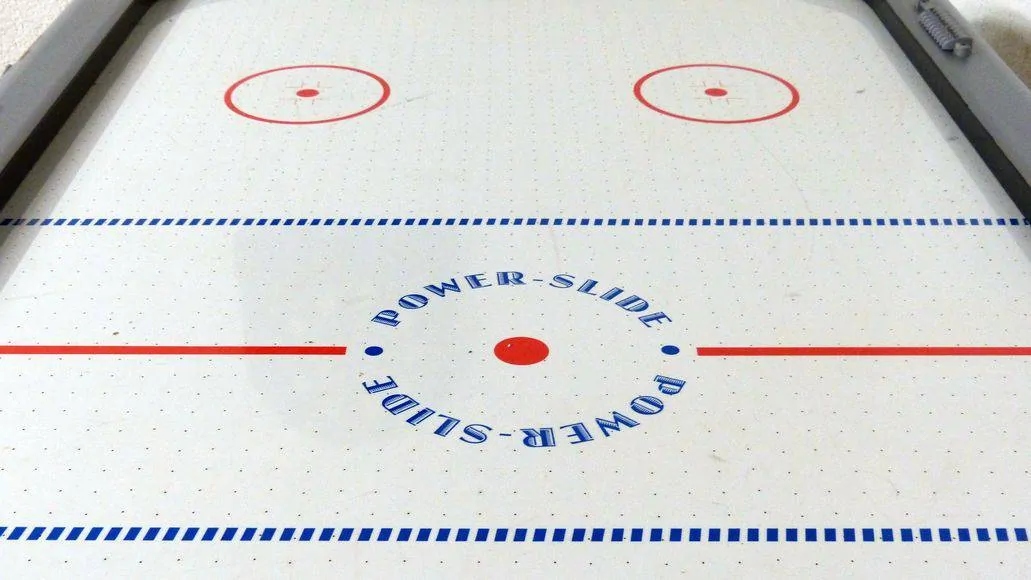Rules Of Air Hockey - Essential Strategies And Techniques
Unlock the secrets of air hockey with our comprehensive guide. From rules of air hockey to advanced strategies, become a master on the air hockey table.
Author:James DavisJan 11, 20246.4K Shares237.3K Views

Air hockey, a fast-paced and exhilarating game, has become a staple in arcades, game rooms, and competitive circuits worldwide. The essence of air hockey lies not only in swift reflexes and precision but also in a deep understanding of rules of air hockey.
All ages enjoy playing the fast-paced, entertaining game of air hockey. Because it's not too hard to learn, air hockey is a terrific game for parties, get-togethers, family get-togethers, and friendly competitions.
Let's learn about some of the basic rules of air hockey:
The Rules For Air Hockey
The rules of air hockey are really simple: the person who scores seven points first wins the round. The game is won by the best seven-round total. Still, you must be aware of the regulations in order to play air hockey effectively. The fundamentals of playing air hockey are as follows:
- To decide who gets to start with the puck in their possession, flip a coin.
- The puck must enter the goal completely to score a point. Pucks that get trapped halfway in or rebound do not count toward the score.
- The puck is next served by the opposing player after a goal is made.
- Only when the puck is on their side of the centerline may a player hit it.
- Mallets are not allowed to strike the puck across the center line.
- As long as they stay on their side of the centerline, players are free to stand behind or next to the game table.
- Anywhere the puck touches the centerline, it is considered fair play for both players.
- Players are not permitted to "top" the puck, which means they cannot raise their mallet and place it over the puck to keep it in place.
- Keep your hands, arms, and other body parts away from the puck.
- Every round, each player is permitted one 10-second time out.
- A player can only request a time out while they are in possession of the puck and it is not in play.
- After a round, rotate who gets to serve first.
Now, we dive into the intricacies of air hockey, unraveling the written and unwritten guidelines that govern this dynamic sport.
Air Hockey Table Setup
A crucial aspect of mastering the rules of air hockey lies in understanding the foundational elements of the game, starting with the setup of the air hockey table. The setup serves as the canvas upon which the dynamic and thrilling game unfolds.
Air hockey tables come in various sizes, but a standard table is typically 8 feet in length and 4 feet in width. The playing surface is adorned with smooth, low-friction materials, ensuring optimal puck glide. Surrounding the playing area are rails that prevent the puck from leaving the table during intense gameplay.
At the heart of the air hockey table is the ingenious air cushion technology. This feature involves a series of tiny holes puncturing the playing surface. When the game begins, a motor generates a steady stream of air, creating a cushion of air that reduces friction. This cushion allows the puck to hover slightly above the surface, enabling swift and unpredictable movements.
Positioned on opposite sides of the table, players prepare to engage in a fast-paced duel. Each player is armed with a striker, also known as a paddle. The strikers are designed for quick and precise movements, allowing players to defend their goal and launch offensive maneuvers.
At either end of the table are goals, the targets for each player. The primary objective is to score points by propelling the puck into the opponent's goal. The puck must completely cross the goal line to count as a point. The strategic placement of goals adds an extra layer of complexity to the game, requiring players to balance offense and defense.
The Opening Serve
With the table impeccably set, the next phase in the journey of air hockey is the commencement of the game. The opening serve is a pivotal moment, setting the tone for the intense and fast-paced exchange that is about to unfold.
The game begins with both players taking their positions at either end of the table. The puck is placed at the center of the playing surface, ready to be propelled into action. Players grip their strikers, eyes fixed on the puck, anticipating the rapid movements that will follow.
The serve can be initiated by either a referee or, in more casual settings, by one of the players. In formal competitions, a referee oversees the game, ensuring adherence to rules and fair play. In friendly matches, players often take turns initiating the serve.
The serve is executed by releasing the puck onto the playing surface. For the puck to be considered in play, it must make contact with the surface before any player makes a move. This criterion ensures a fair start and prevents players from gaining an unfair advantage.
The opening move sets the pace for the entire game. Players aim to strike the puck with a combination of speed and precision, aiming to gain control and potentially score an early point. The rapid exchange of serves and counter-serves adds an element of unpredictability to the game.
The player who makes the first contact with the puck strives to establish dominance. Quick reflexes and strategic positioning are crucial in gaining control of the puck. The opening serve is not merely a formality but a strategic move that can influence the flow of the entire game.
After each round, the serve rotates between players. The player who scores retains the right to serve for the next round. This rotation ensures fairness and equal opportunities for both players to demonstrate their skills.
Scoring
In the electrifying realm of air hockey, scoring is the heartbeat that propels the game forward. A deep understanding of the point system is essential for players seeking victory on the air hockey table.
The primary objective in air hockey is to score points by successfully propelling the puck into the opponent's goal. When the puck completely crosses the goal line, a point is attributed to the player who executed the successful shot. The simplicity of this scoring system is fundamental to the fast-paced nature of the game.
The mechanics of scoring are straightforward: precision and timing determine the success of a shot. The puck must entirely cross the goal line to count as a point. Whether achieved through a swift straight shot, a strategic bank shot off the walls, or a deceptive maneuver, the validation of a goal hinges on the puck's clear traversal of the goal line.
Following a successful shot, the player who scored retains the right to serve for the next round. This system ensures a continuous and dynamic exchange of serves, with both players having the opportunity to initiate the action. The flow of the game remains uninterrupted, maintaining the intense and competitive atmosphere.
Air hockey games typically have a predetermined point threshold for victory. The first player to reach or surpass this threshold is declared the winner. Common thresholds range from 7 to 10 points, depending on the agreed-upon rules or the format of the game. This adds an element of strategy, as players must not only score but also prevent their opponents from reaching the winning threshold.
Fouls And Penalties
While scoring adds excitement to air hockey, navigating the thin line between aggressive play and rule violations is equally crucial. Fouls and penalties, though designed to maintain fair play, require players to tread carefully as they strive for victory.
Palming
Holding the Puck on the StrikerOne common foul in air hockey is palming, where a player holds the puck on the striker for an extended period. This action limits the opponent's ability to defend and disrupts the natural flow of the game. Palming is penalized to prevent unfair advantages and encourage continuous play.
Going Over The Center
Mallets may stray, but they must never go all the way past the centerline. It's a foul if even half of your mallet slips through. Any player may, however, strike while the puck is in contact with the centerline.
Striker Off The Table
A Foul OffenseAllowing the striker to leave the playing surface, whether accidentally or intentionally, is considered a foul. When this occurs, the opponent is awarded possession of the puck, and the game resumes. This rule ensures that the puck remains in play, fostering fair and dynamic competition.
Goal Dislodgment
Intentional DisruptionDeliberately lifting or moving the goal to impede the opponent's scoring opportunity is a violation. This intentional disruption is penalized to maintain the integrity of the game. Goals that are stable and secure contribute to a fair and competitive playing environment.
Double Hit
Fair Play and Equal OpportunitiesStriking the puck more than once consecutively without it rebounding off the opponent's side is considered a double hit and is penalized. This rule ensures fair play and equal opportunities for both players. It prevents one player from gaining an unfair advantage by rapid and consecutive strikes.
In formal competitions or settings with a designated referee, adjudication of fouls falls under their purview. The referee plays a crucial role in ensuring fair play, enforcing rules, and penalizing infractions. Their presence adds an impartial element to the game, fostering an environment of fairness.
Fouls and penalties also extend to preventing unsportsmanlike conduct. Players are expected to compete with respect and integrity. Actions such as taunting, intentional rule violations, or any conduct that goes against the spirit of sportsmanship may result in penalties or warnings.
Defensive And Offensive Strategies
In the high-octane world of air hockey, mastering defensive and offensive strategies is the key to becoming a formidable player. Successful air hockey enthusiasts seamlessly blend both elements to outmaneuver opponents and secure victory on the sleek playing surface.
Balancing Defense And Offense
Effective air hockey gameplay demands a delicate balance between defense and offense. While scoring points is crucial, preventing the opponent from doing so is equally important. Players must assess the situation, deciding when to adopt defensive postures and when to unleash offensive maneuvers. This strategic balance keeps opponents guessing and adds an element of unpredictability to the game.
Goalkeeping
A cornerstone of effective defense in air hockey is goalkeeping. Strategic placement of the striker to block incoming shots requires anticipation and rapid reflexes. Successful goalkeeping involves reading the opponent's movements, predicting shot trajectories, and positioning the striker to create a formidable barrier. This defensive strategy aims to nullify the opponent's scoring opportunities.
Blocking Shots With Precision
A skilled defender not only positions the striker adeptly but also excels at blocking shots with precision. The ability to intercept the puck mid-air, redirecting it away from the goal, is a defensive art. Precision blocking requires a keen understanding of puck trajectories, opponent tendencies, and quick decision-making to thwart offensive advances effectively.
Utilizing Defensive Angles
Defensive angles play a pivotal role in restricting the opponent's scoring options. Players strategically position themselves to create narrow angles for the opponent's shots, making it challenging for them to find openings in the defense. Manipulating defensive angles requires spatial awareness and adaptability, forcing opponents to navigate a maze of defensive barriers.
Countering Offensive Maneuvers
As part of an effective defensive strategy, players must master the art of countering offensive maneuvers. This involves predicting and neutralizing the opponent's shots and moves. A successful counterattack disrupts the opponent's flow, transitions seamlessly into an offensive opportunity, and can catch the opponent off guard.
Rapid Transition From Defense To Offense
The ability to transition rapidly from defense to offense is a hallmark of skilled air hockey players. As soon as a defensive play is executed, players must be ready to capitalize on the turnover and launch a swift counterattack. Seamless transitions keep opponents on the defensive and create opportunities for scoring.
Unwritten Etiquette
Beyond the written rules, air hockey operates on a foundation of unwritten etiquette that defines the spirit of sportsmanship. Adhering to these principles contributes to a positive and enjoyable playing environment.
Handshakes And Acknowledgments
Before and after a game, players often exchange handshakes as a sign of respect. Acknowledging well-played shots, regardless of the scorer, fosters a sense of camaraderie. These gestures contribute to a positive and friendly atmosphere, emphasizing the shared love for the game.
Respecting Opponents
Respecting opponents is fundamental to the spirit of sportsmanship. Avoiding overly aggressive play, intentional rule violations, or unsportsmanlike conduct ensures a more enjoyable experience for all players. Fair play and respect for opponents create an environment conducive to healthy competition.
Sharing The Table
In settings where multiple players are waiting for their turn, it is customary to limit the time spent on the table. Sharing the playing space allows everyone to have a fair chance at enjoying the game. Consideration for others reflects a commitment to sportsmanship beyond individual performance.
Gracious In Victory, Graceful In Defeat
Whether celebrating a victory or acknowledging defeat, players are encouraged to be gracious. Celebrating success without flaunting it and accepting defeat with grace contribute to the overall sportsmanship ethos. These moments of humility and resilience define the character of a true air hockey enthusiast.
Avoiding Disruptive Behavior
Disruptive behavior, such as excessive celebrations, taunting, or unsportsmanlike comments, has no place in air hockey. Players are encouraged to compete with intensity but within the bounds of respect and consideration. Maintaining focus on the game and avoiding distractions contribute to a positive atmosphere.
FAQs
How Is Air Hockey Played?
Air hockey is played on a smooth table with two players using strikers to hit a puck into the opponent's goal. The table's surface is equipped with air holes, creating a cushion of air that allows the puck to glide freely.
What Are Common Fouls In Air Hockey?
Common fouls in air hockey include palming (holding the puck on the striker), striker off the table, goal dislodgment, and double hits. These fouls are penalized to maintain fair play.
What Is The Role Of The Referee In Air Hockey?
The referee initiates the game by releasing the puck for the opening serve. During the game, the referee enforces rules, calls fouls, and ensures fair play.
Can Air Hockey Be Played In Tournaments?
Absolutely, air hockey tournaments are common, offering players the opportunity to showcase their skills in a competitive environment.
Final Words
Air hockey transcends being merely a game with rules; it is an experience that combines skill, strategy, and the sheer joy of competition. Whether played casually among friends or in the intense arena of competitive championships, air hockey continues to capture the hearts of enthusiasts. Mastering the rules of air hockey is just the beginning; it's the fusion of skill, strategy, and sportsmanship that transforms air hockey into an unwritten symphony of exhilaration and camaraderie.

James Davis
Author
James Davis keeps you updated daily with the best shopping tricks, hacks, and frugal living tips that you won’t find anywhere else. He also talks and writes about creative ways to save money, job opportunities like clever ways to make money from home, great jobs for teens, and online jobs that pay well.
James also enjoys working on Social Media campaigns for major brands. He believes in creating a personal relationship between the brand and its consumers. He is very much into taking the corporate out of the brand and bringing it down to the level where consumers can feel comfortable interacting and taking the brand seriously.
Latest Articles
Popular Articles

